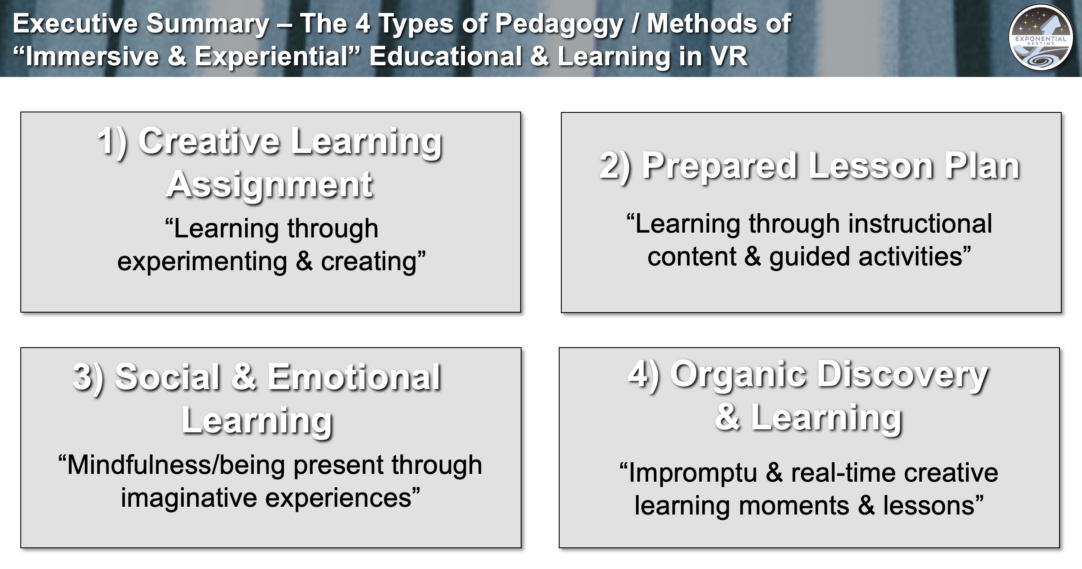What We Have Learned from our Research To-Date
At Exponential Destiny we take a research-based approach to the pilots and projects we conduct. After all, this is a new emerging capability, and thus we like to experiment and explore to untap the real potential of using “immersive and experiential” methods in our work with our clients and partners. From these experiments, we then observe and learn how to optimize this new emerging tool and medium of communication, collaboration, and learning.
We are proud to say that after numerous pilots and projects with public schools and social impact organizations, we have accumulated the research and synthesized the data from the key learnings and applied them to our methodology moving forward. We are now confident that we have the empirical data and insights to effectively and efficiently work with additional schools and related impact organizations (on a limited budget) to assist them in exploring, adopting, and optimizing their use of immersive and experiential educational methods, powered by VR and metaverse technologies. Listed below is a summary of some of these key learnings and insights.
Key Learnings – Our research and pilots have taught us and helped us discover the following:
Click each item for more information
Teachers Tell Us: “This makes teaching fun again” – Abundance vs. Scarcity Mindset
| Once we put VR headsets into the hands of teachers and provided them basic training so they truly understood the “art of the possible” of what they could do in these simulated and virtual environments, each one of them expressed their excitement for being a teacher with these new capabilities. “This has made me excited to be in this profession again!”.
Essentially, they saw the potential to supplement how they created curriculum and the new toolset they now had to leverage in teaching their students. As one teacher said, “I used to operate with a mindset of ‘scarcity’ – limited resources at my disposal to leverage in my classroom to help teach a subject – to ‘abundance’. The ‘unlimited’ digital real-estate and assets in VR opened the door for educators to use their full imagination without limits as they created their curriculum. These new ‘super-powers’ motivated these teachers we worked with, and ultimately reinvigorated their passion for teaching again. It re-sparked their innovation muscle! |
Meet Kristen Whitaker – 2015 Toyota Teacher of the Year Award Recipient & Associate Director of Digital Learning at the National Center for Families Learning. Kristen comments on her advocacy for using VR to bring immersive and experiential learning methods into the classroom. |
| Once we put VR headsets into the hands of teachers and provided them basic training so they truly understood the “art of the possible” of what they could do in these simulated and virtual environments, each one of them expressed their excitement for being a teacher with these new capabilities. “This has made me excited to be in this profession again!”.
Essentially, they saw the potential to supplement how they created curriculum and the new toolset they now had to leverage in teaching their students. As one teacher said, “I used to operate with a mindset of ‘scarcity’ – limited resources at my disposal to leverage in my classroom to help teach a subject – to ‘abundance’. The ‘unlimited’ digital real-estate and assets in VR opened the door for educators to use their full imagination without limits as they created their curriculum. These new ‘super-powers’ motivated these teachers we worked with, and ultimately reinvigorated their passion for teaching again. It re-sparked their innovation muscle!
Meet Kristen Whitaker – 2015 Toyota Teacher of the Year Award Recipient & Associate Director of Digital Learning at the National Center for Families Learning. Kristen comments on her advocacy for using VR to bring immersive and experiential learning methods into the classroom. |
Training and Learning in VR Compliments – and May Even Outperform - Classroom or On-Line Methods
Faced with the issues and market failures in the public education system (per above), it is clear that innovation is essential to meet these challenges. Fortunately, in early 2020 there was a significant inflection point in the advancement and innovation of virtual reality (VR) capabilities – i.e., exponentially improving quality of experience combined with dramatically declining cost for hardware and software. As important, there were some early efficacy studies that were emerging that were signaling game-changer potential when introducing immersive and experiential methods of learning to students within VR.
One noteworthy initial efficacy study really struck a chord with us at Exponential Destiny. Specifically, the following 2020 Price Waterhouse Coopers (PwC) independent study (see Chart) :

(full report: https://www.pwc.com/us/en/tech-effect/emerging-tech/virtual-reality-study.html)
The report highlights the dramatic (exponential vs. incremental) improvements in training and education when comparing learning in Virtual Reality to classroom and on-line learning approaches.
Furthermore, what was interesting to us at Exponential Destiny about this PwC study is that it was released in 2020, thus was actually preformed using VR technology from 2019, which was pre-Covid pandemic. We knew that due to the global Covid pandemic, there was a sharp and sudden rise in interest and demand for remote digital collaboration, and we observed first-hand how innovation in VR technology accelerated dramatically in 2020 and 2021. Thus, our feeling was that this PwC study was already outdated since the technology had advanced so much since this study was conducted, and therefore our assumption was that the integration of VR into education using the latest VR tools would most likely be significantly more effective and impressive if conducted today.
This is part of our mission today for why we created Exponential Destiny, to further explore this untapped potential of VR being used in education using the latest technology available, and specifically when applied in public schools in marginalized communities where the education system is suffering the most.
However, our big question was whether the impressive results of the 2020 PwC study (above) – which was more centric to corporate training and education environments – could be achieved in the public education system, and furthermore could it be effective, affordable, and scalable in under-resourced – even struggling – lower income communities?
This curiosity – as to the real potential of VR in public education within under-served communities – is the basis of the work we do today.
We feel there is real potential because from our own work in this field we know that the technical aptitude required to create in these environments has become very low; for example, the required skillset to become a creator in the metaverse, using various new Metaverse design platforms, was more akin to “power-point in 3D” vs. writing computer programming code. In other words, a non-technical person, like a high school student or teacher, using no programming/coding skillset, could create and even thrive in using and even developing these virtual environments. We see the potential opportunity for a school to be self-sufficient and not dependent on outside costly resources, since students and teachers can be easily trained in these environments and use the capability to create new educational pedagogies.
Also, in talking with educators, it was clear a teacher in an under-performing public school would be ecstatic with even fractional results as was reported in the PwC efficacy study, and thus we felt this potential result would be an incentive for a traditional school (not typically willing or able to try new things) to at least experiment and explore the potential of this new capability.
Lastly, since Exponential Destiny’s leadership team was comprised predominantly of recent high school graduates from an under-resourced school community in south-central Los Angeles, we knew first-hand the potential to use these immersive and experiential digital environments to entice and engage students to partake in their education. We personally discovered how fun and creative it was to learn in VR, especially when applying “edu-tainment” based methods, incorporating prize and game-theory.
The puzzle started to come together, and at Exponential Destiny we felt a passion that led to the formulation of a mission to explore, research, and pioneer the adaptation and adoption of VR and related Metaverse innovations into the struggling public education system to address the Issues and Market Failures described previously (above).
As a result of doing our own experimentation with introducing VR into public high schools in under-resourced communities, we have developed some of our own research results and insights. You can review those here
Behavioral Change Management vs. Technical Implementation
| Doing a pilot with a school or traditional educational organization requires a significant focus on the change management aspect of working with a group of students, teachers, and administrators to explore and potentially adopt a new innovation and method. Changing behaviors in these types of traditional environments – willingness to try new things, experiment, and keep an open-mind to the potential – is actually the real art of these projects versus the technical and system training in VR. Students and teachers didn’t really struggle at all with the technical side of these pilots (i.e., getting into and using the headsets, accessing the software, creating new virtual environments, etc.). Our real focus is discovering how to adopt and adapt this technology in these traditional environments to compliment and/or supplement education and learning, which requires behavioral changes. As a result, during our projects we incorporate professional change-management techniques that help change behaviors, not just with the students, but also with the teachers and administrators to embrace and experiment with innovation (vs. being scared of it). We also noticed that young people are naturally digitally native and used to manipulating these digital worlds, and thus their receptivity to trying, and even embracing VR methods of learning, is actually very high. Students are engaged in their education, by choice! | 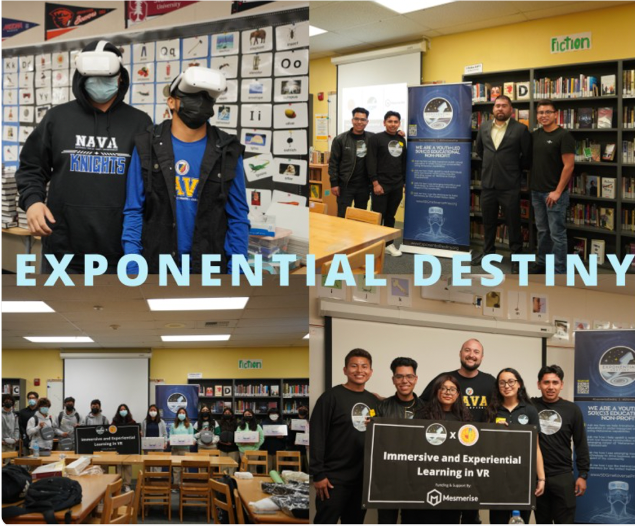 |
| Doing a pilot with a school or traditional educational organization requires a significant focus on the change management aspect of working with a group of students, teachers, and administrators to explore and potentially adopt a new innovation and method. Changing behaviors in these types of traditional environments – willingness to try new things, experiment, and keep an open-mind to the potential – is actually the real art of these projects versus the technical and system training in VR. Students and teachers didn’t really struggle at all with the technical side of these pilots (i.e., getting into and using the headsets, accessing the software, creating new virtual environments, etc.). Our real focus is discovering how to adopt and adapt this technology in these traditional environments to compliment and/or supplement education and learning, which requires behavioral changes. As a result, during our projects we incorporate professional change-management techniques that help change behaviors, not just with the students, but also with the teachers and administrators to embrace and experiment with innovation (vs. being scared of it). We also noticed that young people are naturally digitally native and used to manipulating these digital worlds, and thus their receptivity to trying, and even embracing VR methods of learning, is actually very high. Students are engaged in their education, by choice!
|
Everyone Can Participate - All Skill Levels and Right or Left Brain “and it’s Fun”!
| Another interesting observation from our pilots and research is that no one felt left out; “left-brain” and ”right-brain” individuals. In Chicago for example (link to Chicago project), the Art teacher was one of the most active pioneers of the use of VR in the classroom to improve education. She advocated for not just using it in her art classes, but with all school subjects. Students who performed well in quantitative and STEM-based subjects quickly adapted and remained intellectually curious about the technical features and functions of the hardware and Metaverse software, while artistic-oriented (non-technical) students appreciated and had fun with the creative aspects of working in VR. | 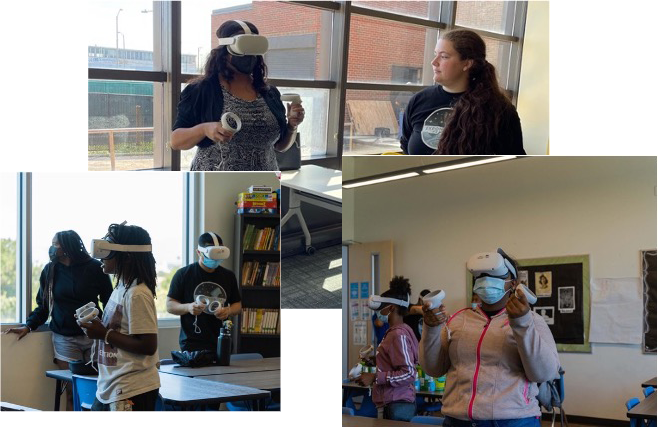 |
|
Another interesting observation from our pilots and research is that no one felt left out; “left-brain” and ”right-brain” individuals. In Chicago for example (link to Chicago project), the Art teacher was one of the most active pioneers of the use of VR in the classroom to improve education. She advocated for not just using it in her art classes, but with all school subjects. Students who performed well in quantitative and STEM-based subjects quickly adapted and remained intellectually curious about the technical features and functions of the hardware and Metaverse software, while artistic-oriented (non-technical) students appreciated and had fun with the creative aspects of working in VR.
|
Self-Sufficiency is Achievable (even with a limited budget and resources)
“It’s Obvious Why it Works So Well” – Bring on the Edu-Tainment and Gamification!
| Through our research, we often heard from anyone that truly comprehended the full capabilities of working in immersive and experiential learning environments in VR, that “anything is possible”. Everyone agrees that “learning through experience” is always optimal, whether it be in a real environment (e.g., going on a class fieldtrip to a biology lab) or in a simulated environment. In addition, in VR you can start to apply – what we call at Exponential Destiny – “wow” factors to “bring to life” the experience in ways you couldn’t even do in real-physical environments. For example, special effects, story-telling, and most importantly applying game-theory, or “gamification” techniques, to actively engage your learners into their education. Once a student or teacher understood this broader toolset they have in VR, it becomes almost obvious as to the potential for reimaging education and learning. |  |
| Through our research, we often heard from anyone that truly comprehended the full capabilities of working in immersive and experiential learning environments in VR, that “anything is possible”. Everyone agrees that “learning through experience” is always optimal, whether it be in a real environment (e.g., going on a class field trip to a biology lab) or in a simulated environment. In addition, in VR you can start to apply – what we call at Exponential Destiny – “wow” factors to “bring to life” the experience in ways you couldn’t even do in real-physical environments. For example, special effects, story-telling, and most importantly applying game-theory, or “gamification” techniques, to actively engage your learners into their education. Once a student or teacher understood this broader toolset they have in VR, it becomes almost obvious as to the potential for reimaging education and learning.
|
Attitude – Don’t Be Afraid to Fail…Experimentation is How You Learn in this Environment
| Because these simulated environments are digital and virtual, there is no limit to what your imagination may produce. You may try some gamification techniques (e.g., “Ok students how about a game of Jeopardy in VR?! Or a Scavenger Hunt to test what you just learned”) or other aspects of “edu-tainment” to optimize the learning experience. The truth is that this is a new emerging art form and method of communication, and thus there are no “rules” or even best practices established yet. This means that teachers and students really need to go into this process with the mindset of “not afraid to fail”. In other words, just get in and start creating experiences. Brainstorm. Ideate. Worst case scenario is you spend a few hours creating something in VR that you don’t think works that well, so you fail-and-learn. The cost of “failure” is low since you are dealing with digital real-estate and assets. You can simply hit “delete” and start again with something new. Since this field is so early, students and teachers need to experiment with different techniques and approaches for learning in VR. What works for a 15-year-old girl in VR to learn a particular subject may be very different than what works well for a 15 year-old boy. It’s only through experimenting with various approaches that one will ultimately discover how to “crack the code” on teaching a particular subject in VR | 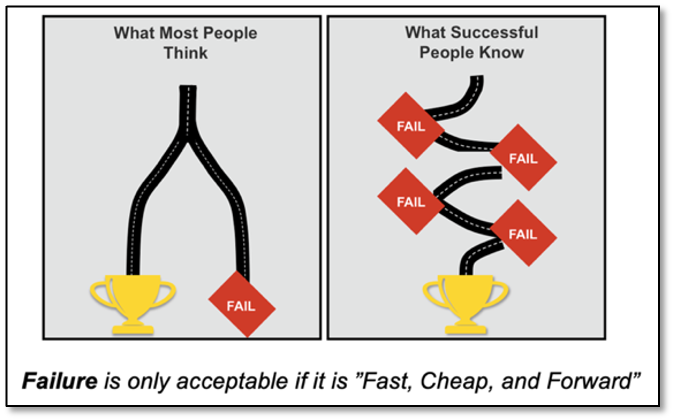 |
| Because these simulated environments are digital and virtual, there is no limit to what your imagination may produce. You may try some gamification techniques (e.g., “Ok students how about a game of Jeopardy in VR?! Or a Scavenger Hunt to test what you just learned”) or other aspects of “edu-tainment” to optimize the learning experience. The truth is that this is a new emerging art form and method of communication, and thus there are no “rules” or even best practices established yet. This means that teachers and students really need to go into this process with the mindset of “not afraid to fail”. In other words, just get in and start creating experiences. Brainstorm. Ideate. Worst case scenario is you spend a few hours creating something in VR that you don’t think works that well, so you fail-and-learn. The cost of “failure” is low since you are dealing with digital real-estate and assets. You can simply hit “delete” and start again with something new. Since this field is so early, students and teachers need to experiment with different techniques and approaches for learning in VR. What works for a 15-year-old girl in VR to learn a particular subject may be very different than what works well for a 15 year-old boy. It’s only through experimenting with various approaches that one will ultimately discover how to “crack the code” on teaching a particular subject in VR.
|
Students Understand the Broader Upskilling Potential…. and that’s Motivating
| It was clear to us in working with students to conduct these pilots that many of them started to realize that the skillset they were learning was a “relevant” competency for the emerging new job-market and economy that is accompanying this next generation of the internet. They realize this in-part because their training on these projects was by Metaverse experts from Exponential Destiny who they themselves were of similar age and from a similar background. The Exponential Destiny leads shared with the students how they now had careers in this field and were able to make professional income, and this motivated students to learn this emerging technology, not just to help their school as part of the pilot project, but as a skillset that would be relevant to them in the broader job market. | Meet Juan Felix. In this short video Juan shares his journey and how after he was mentored by Exponential Destiny in Metaverse design at age 19 he went from working in retail at Target Stores to leading the new VR department for a billion-dollar corporation. (This video of Juan is an excerpt from a keynote presentation that Exponential Destiny delivered at the United Nations ITU summit in Geneva, Switzerland. |
| It was clear to us in working with students to conduct these pilots that many of them started to realize that the skillset they were learning was a “relevant” competency for the emerging new job-market and economy that is accompanying this next generation of the internet. They realize this in-part because their training on these projects was by Metaverse experts from Exponential Destiny who they themselves were of similar age and from a similar background. The Exponential Destiny leads shared with the students how they now had careers in this field and were able to make professional income, and this motivated students to learn this emerging technology, not just to help their school as part of the pilot project, but as a skillset that would be relevant to them in the broader job market.
Meet Juan Felix. In this short video Juan shares his journey and how after he was mentored by Exponential Destiny in Metaverse design at age 19 he went from working in retail at Target Stores to leading the new VR department for a billion-dollar corporation. (This video of Juan is an excerpt from a keynote presentation that Exponential Destiny delivered at the United Nations ITU summit in Geneva, Switzerland.
|
Defining New Educational Pedagogies – How Teachers Teach in VR and How Students Learn
|
Through our research and pilots we have started to notice patterns in how teachers are using the platform to optimize education, as well as how students are learning in these simulated environments. Specifically, we have defined 4 types of educational pedagogies. (We cover each pedagogy in our Broward County Florida school’s “Game-Changer” Summit . Click the video (right) to view the portion of our “Game Changer” Summit video, where Samantha discusses the first educational pedagogy. It is worth highlighting the first pedagogy to give an example of the potential of our approach; “Creative Learning Assignment” – In this approach, students learn by creating. A teacher may issue a “research report” or book-report assignment to her class on a subject, say “U.S. History in the 19th Century”. Students will then research the subject using current or even traditional methods (e.g., internet research, library, reading a book on the topic, interviewing an expert, teacher providing a lecture, etc.). However, rather than preparing the research report in a power-point presentation or written paper that they read in front of the class, they instead are asked to share what they learned by creating a story and environment within the Metaverse/VR. They could even do this as small student teams in the class, with each group of students working together to create their environment in VR. Then, each team will provide a ”tour” for the other student teams by inviting them to come through their environment in VR. Notice in this model that the teacher just needed to administer and organize the assignment for the class, but the teacher actually didn’t have to create in VR, as that is what the students do (and are naturally good at it as digital natives). Ultimately what we found with this approach is that it is fun and students really enjoy it. It is interactive and digital. But more importantly, students have told us that, “creating an environment in VR using and placing digital objects, images, audio in order to share with my classmates what I have learned, really reinforced that topic in my mind”. This is the untapped value of VR; students use their spatial memory – a proven aspect for how or minds retain information – while also learning through simulated experience. Even if the environment that a student or student team creates in VR as part of this approach isn’t very “polished” or all that creative or professional, it doesn’t matter… they learn by creating. Students tell us this is highly more effective than watching a 2D video on a subject or listening to a lecture on a topic. For a teacher, if a student team does create a highly effective learning experience around a topic in VR using this method, this is now an “asset” that can be ameliorated by other students over the years, cultivated into a shared asset for future students to benefit. |
|
|
Through our research and pilots we have started to notice patterns in how teachers are using the platform to optimize education, as well as how students are learning in these simulated environments. Specifically, we have defined 4 types of educational pedagogies. (We cover each pedagogy in our Broward County Florida school’s “Game-Changer” Summit. Click the video below to view the portion of our “Game Changer” Summit video where Samantha discusses the first educational pedagogy. It is worth highlighting the first pedagogy to give an example of the potential of our approach; “Creative Learning Assignment” – In this approach, students learn by creating. A teacher may issue a “research report” or book-report assignment to her class on a subject, say “U.S. History in the 19th Century”. Students will then research the subject using current or even traditional methods (e.g., internet research, library, reading a book on the topic, interviewing an expert, teacher providing a lecture, etc.). However, rather than preparing the research report in a power-point presentation or written paper that they read in front of the class, they instead are asked to share what they learned by creating a story and environment within the Metaverse/VR. They could even do this as small student teams in the class, with each group of students working together to create their environment in VR. Then, each team will provide a ”tour” for the other student teams by inviting them to come through their environment in VR. Notice in this model that the teacher just needed to administer and organize the assignment for the class, but the teacher actually didn’t have to create in VR, as that is what the students do (and are naturally good at it as digital natives). Ultimately what we found with this approach is that it is fun and students really enjoy it. It is interactive and digital. But more importantly, students have told us that, “creating an environment in VR using and placing digital objects, images, audio in order to share with my classmates what I have learned, really reinforced that topic in my mind”. This is the untapped value of VR; students use their spatial memory – a proven aspect for how or minds retain information – while also learning through simulated experience. Even if the environment that a student or student team creates in VR as part of this approach isn’t very “polished” or all that creative or professional, it doesn’t matter… they learn by creating. Students tell us this is highly more effective than watching a 2D video on a subject or listening to a lecture on a topic. For a teacher, if a student team does create a highly effective learning experience around a topic in VR using this method, this is now an “asset” that can be ameliorated by other students over the years, cultivated into a shared asset for future students to benefit.
|
Potential for a Broader Network Effect at Scale
| Last but not least, we spoke to many school district administrators that were interested in a strategy for how this capability could scale effectively and be optimized within their network of schools. In summary, we have started to think about the “network effect” that could be created within a school district, whereby a “division of labor” concept is applied, or what we call in this context, a “division of learning”.
Specifically, rather than each school attempting to design and create educational assets in VR for each subject (i.e., try to be good at everything) the notion would be that each school in a school district would select a particular subject matter; a divide-and-conquer approach. For example, math or science, or history, or reading/writing, etc., each school selects one topic and then uses VR to create and optimize educational and learning assets for their subject matter. This specialized approach will result in optimized asset creation overtime. Eventually the entire school district may “copy and paste” and share these lesson plans and VR assets with all of the schools in their district. This sharing of assets, that were perfected by a particular group of schools for each subject, now has a network effect for the entire school district. |
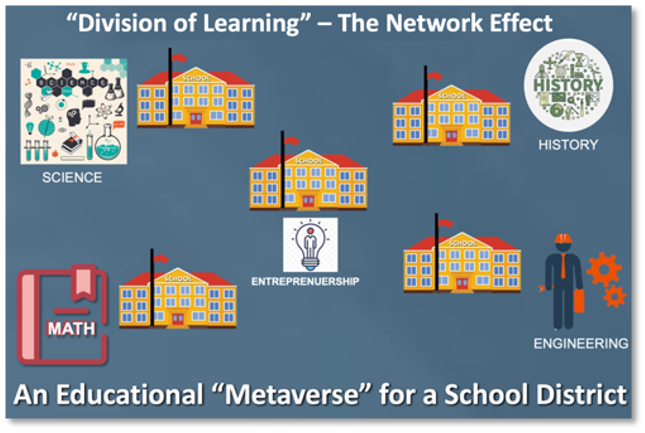 |
| Last but not least, we spoke to many school district administrators that were interested in a strategy for how this capability could scale effectively and be optimized within their network of schools. In summary, we have started to think about the “network effect” that could be created within a school district, whereby a “division of labor” concept is applied, or what we call in this context, a “division of learning”.
Specifically, rather than each school attempting to design and create educational assets in VR for each subject (i.e., try to be good at everything) the notion would be that each school in a school district would select a particular subject matter; a divide-and-conquer approach. For example, math or science, or history, or reading/writing, etc., each school selects one topic and then uses VR to create and optimize educational and learning assets for their subject matter. This specialized approach will result in optimized asset creation overtime. Eventually the entire school district may “copy and paste” and share these lesson plans and VR assets with all of the schools in their district. This sharing of assets, that were perfected by a particular group of schools for each subject, now has a network effect for the entire school district.
|
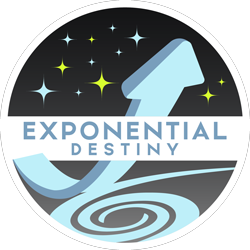
Follow Us
